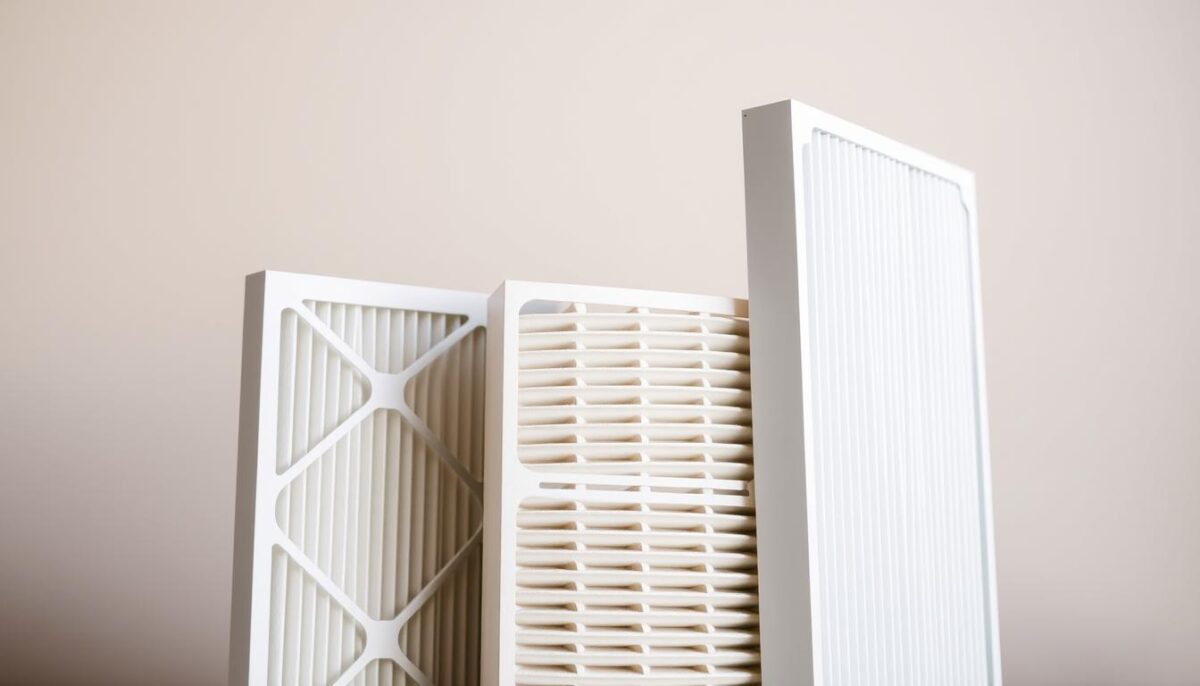The Best HVAC Filters for Arizona Allergy Sufferers
Arizona’s desert climate creates a unique set of challenges for individuals suffering from allergies. The dry air is filled with dust, pollen, and other particulates that can exacerbate respiratory issues and discomfort.
High-quality air filters can significantly improve indoor air quality by capturing these allergens before they circulate through your home.
Understanding the right HVAC filters for your system can dramatically reduce allergy symptoms and improve your quality of life. This guide will help you navigate the complexities of filtration technology and choose the optimal filter for your specific needs.
Key Takeaways
- Learn how Arizona’s desert climate affects indoor air quality and allergy sufferers.
- Understand the importance of proper HVAC filtration in reducing allergy symptoms.
- Discover the different rating systems for air filters and what specifications matter most.
- Find out how to select the optimal air filter for your specific allergy needs and system compatibility.
- Get insights into maintaining healthy indoor air quality with the right HVAC filter.
Understanding Arizona’s Unique Allergy Challenges

Arizona’s desert climate presents a distinct set of allergy challenges that differ significantly from other regions. The state’s hot, dry climate creates ideal conditions for dust, pollen, and other allergens to become airborne, introducing a variety of allergens into homes.
The desert environment, combined with seasonal monsoons, plays a crucial role in determining the types and concentrations of airborne allergens throughout the year. This unique combination results in dramatic fluctuations in allergen types and concentrations, making it challenging for residents to manage their allergies effectively.
Common Allergens in Arizona’s Environment
Arizona is home to several common allergens, including desert ragweed, bermuda grass, and mulberry trees, which are among the most problematic pollen producers. The fine dust and particulate matter common in Arizona’s environment can easily infiltrate homes, compromising indoor air quality. Dust mites and mold spores, which can flourish during humid monsoon seasons, add to the complexity of allergy challenges in the region.
How Arizona’s Climate Affects Indoor Air Quality
The extreme temperature differences between indoor and outdoor environments in Arizona can create pressure differentials that draw more outdoor allergens into homes without proper sealing and filtration. During monsoon season, increased humidity levels can lead to mold growth, further deteriorating indoor air quality. Therefore, it’s essential to implement effective filtration solutions to maintain good air quality within homes.
By understanding these unique challenges, residents can take proactive steps to mitigate their allergy symptoms, such as using high-quality HVAC filters designed to capture a wide range of airborne particles and allergens.
How HVAC Filters Combat Allergy Symptoms

HVAC filters play a pivotal role in combating allergy symptoms by capturing airborne allergens. For Arizona residents, where unique environmental factors contribute to high allergy rates, the right HVAC filter can make a significant difference in indoor air quality.
The Science Behind Filtration and Allergen Capture
The filtration process in HVAC systems works through multiple mechanisms to capture airborne particles. Interception, impaction, and diffusion are the primary methods by which filters trap particles of various sizes. Higher-quality filters, especially those with electrostatically charged fibers, can capture even the smallest allergens like pollen, pet dander, and dust mites.
Benefits of High-Quality Filters for Allergy Sufferers
Using high-quality HVAC filters can significantly reduce allergy symptoms. By capturing airborne allergens, these filters prevent particles from circulating through the home, thereby reducing symptoms like sneezing, congestion, and itchy eyes. Beyond immediate symptom relief, high-quality filters can improve sleep quality and reduce dependency on allergy medication.
| Filter Type | Allergen Capture Efficiency | Benefits for Allergy Sufferers |
|---|---|---|
| Basic Filters | Low | Limited relief from allergy symptoms |
| High-Quality Filters (MERV 13+) | High | Significant reduction in allergy symptoms, improved sleep quality |
Understanding HVAC Filter Ratings for Allergies
For those battling allergies in Arizona, understanding HVAC filter ratings is crucial for cleaner indoor air. The effectiveness of an HVAC filter in capturing allergens depends largely on its rating. There are several rating systems used to measure filter performance, and understanding these can help homeowners make informed decisions.
MERV Rating System Explained
The MERV (Minimum Efficiency Reporting Values) rating system is the industry standard for measuring a filter’s ability to capture particles of different sizes. MERV ratings range from 1 to 20, with higher numbers indicating better filtration. For Arizona allergy sufferers, filters with MERV ratings between 11-13 are generally recommended as they provide excellent allergen capture while maintaining proper airflow in most residential HVAC systems.
MPR and FPR Rating Systems
Besides MERV, other rating systems include MPR (Microparticle Performance Rating) developed by 3M, which focuses on capturing microscopic particles, and FPR (Filter Performance Rating) used by Home Depot, which considers multiple factors including particle capture efficiency and dust holding capacity. MPR ratings range from 100-2800, with 1500-1900 being suitable for allergies, while FPR ratings range from 4-10, with 9-10 being best for allergy sufferers.
Which Rating System is Best for Allergy Sufferers
While different rating systems exist, the key is understanding their correlation. For most Arizona allergy sufferers, filters equivalent to MERV 11-13, MPR 1500-1900, or FPR provide the optimal balance of allergen removal and system performance. As “The right filter can significantly reduce allergy symptoms by capturing more allergens,” making it essential to choose a filter that balances filtration efficiency with system compatibility.
Best HVAC Filters for Allergies in Arizona Homes
The final output is enclosed in the tag and is in American English.
Choosing the Right Filter Size and Type for Your HVAC System
For those suffering from allergies in Arizona, the first step towards relief is selecting an HVAC filter that fits their system perfectly. The right filter size ensures a snug fit without gaps that allow unfiltered air to bypass the filter, capturing allergens and pollutants effectively.
How to Measure Your Filter Size
Properly measuring your existing filter is crucial for Arizona homeowners. To get the correct size, measure the actual dimensions of your current filter rather than relying on the nominal size printed on it, as these can differ by up to ½ inch depending on the manufacturer. Common filter sizes include 10x20x1″, 14x20x1″, 16x24x1″, and 18x30x1″.
Compatibility Considerations for Arizona HVAC Systems
Arizona’s climate puts additional strain on HVAC systems, making compatibility a key consideration. While thicker filters (4-inch vs. 1-inch) can provide better filtration and longer life, they may not be compatible with all HVAC systems. Many Arizona HVAC systems are designed to accommodate higher MERV filters, but older systems may require professional assessment before upgrading.
| Filter Type | Compatibility | Benefits |
|---|---|---|
| 1-inch Standard Filters | Most HVAC systems | Easy to replace, cost-effective |
| 4-inch Media Filters | Some HVAC systems, check compatibility | Better filtration, longer life |
Balancing Filtration Efficiency with Airflow
Arizona’s extended cooling season makes balancing filtration efficiency with airflow particularly important. Higher MERV ratings can restrict airflow, potentially causing system strain if not properly matched to the system’s capabilities. Homeowners should consider consulting with an HVAC professional to determine the best filter for their system, especially if they have severe allergy concerns.
Maintenance Schedule for Maximum Allergy Protection
In Arizona’s dusty environment, a well-planned HVAC filter maintenance schedule can significantly reduce allergy symptoms. Regular maintenance ensures optimal system performance and allergen capture, providing relief for allergy sufferers.
Optimal Replacement Frequency for Arizona Homes
Standard recommendations suggest replacing HVAC filters every 60-90 days, but homes with allergy sufferers should consider more frequent changes, typically every 30-45 days. For maximum allergy protection, Arizona homeowners should inspect filters monthly and be prepared to replace them during high pollen seasons or after significant dust events.
Arizona’s unique climate demands a more aggressive filter replacement schedule than national guidelines suggest. Visual inspection of filters can be misleading, as fine desert dust particles can restrict airflow even when they don’t appear visibly dirty.
Seasonal Considerations for Filter Changes
Creating a seasonal maintenance calendar specific to Arizona’s climate patterns can help ensure optimal filtration year-round. Special attention should be given to monsoon season when increased humidity can lead to mold growth, making filter changes more important.
Maintaining a consistent replacement schedule not only improves allergen capture but also protects your HVAC system from restricted airflow, potentially extending equipment life in Arizona’s demanding climate. Consider keeping extra air filters on hand during peak allergy seasons or before predicted dust storms.
Beyond Filters: Creating an Allergy-Friendly Home in Arizona
Beyond high-quality HVAC filters, several strategies can help Arizona homeowners minimize allergens and improve air quality. Using portable HEPA air purifiers in bedrooms and living areas can provide additional relief for allergy sufferers.
Regular cleaning protocols, such as damp-dusting and using vacuum cleaners with HEPA filtration, are crucial in addressing Arizona’s unique dust challenges. Managing indoor humidity levels is also vital, as extremely dry air can increase allergen mobility, while high humidity can promote mold growth.
For homes with pets, measures like weekly bathing, designated pet-free zones, and specialized pet dander filters can significantly reduce allergens. Upgrading to a central vacuum system and leveraging Arizona’s sunlight to kill dust mites on bedding are additional strategies. By implementing these approaches, Arizona residents can create a more allergy-friendly home environment and improve overall air quality.




